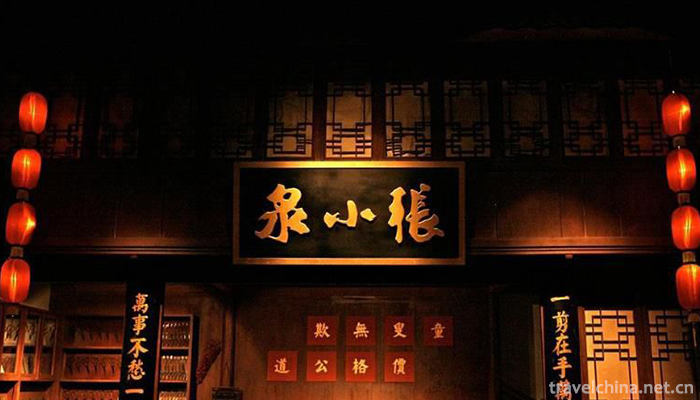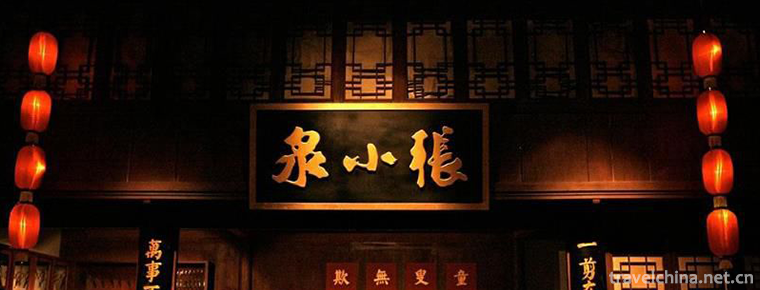Forging Skill of Zhang Xiaoquans Scissors
Forging Skill of Zhang Xiaoquans Scissors
Zhang Xiaoquan scissors forging technology, local traditional handicraft in Hangzhou, Zhejiang Province, one of the national intangible cultural heritage.
In 1663, Zhang Xiaoquan's scissors were first created in Hangzhou, and later became one of the famous "five Hangzhou" products. The development of "Zhang Xiaoquan" scissors has experienced a historical period from traditional handicraft to modern production.
On May 20, 2006, Zhang Xiaoquan's scissors forging technology was approved by the State Council of the People's Republic of China and listed in the first batch of national intangible cultural heritage list, item number_-38.
historical origin
Zhang Xiaoquan's scissors were famous in the late Ming and early Qing Dynasties. Zhang Xiaoquan's father, Zhang Sijia, was famous for his "three knives" in Wuhu when he was young. Later, beside Yixian City, Zhang Dalong opened a "scissors shop" in front of and behind his shop. Zhang Sijia is earnest in his work. His grinding scissors are tough and sharp, which are highly praised by people. Koizumi, under his father's careful instruction and constant practice, has also practiced a good hand-made scissors. When the Qing soldiers entered the Customs, their father and son fled to Hangzhou. In the big shaft and lane at the foot of Wushan, Zhang Dalong's scissors workshop was opened, and their casting skills were carefully studied. In the process of making scissors, the process of "inlaying steel" (also called inlaying steel) was used. Instead of using pig iron to forge scissors, Longquan and Yunhe steels of Zhejiang Province were chosen. The fine mud of Zhenjiang specialty was carefully grinded to make the scissors shining and prosperous. After Zhang Xiaoquanzi inherited his father's business, his business was thriving and ten times more prosperous because of his earnest production and excellent quality, and his location in Qinghefang, a commercial center in Hangzhou. In the second year of Emperor Kangxi of Qing Dynasty (1663 AD), in order to prevent others from selling scissors with Zhang Dalong's signboard, he changed the signboard to his own name "Zhang Xiaoquan".
It is said that when Emperor Qianlong of the Qing Dynasty went down the Yangtze River for the second time to Hangzhou, he disguised himself, mingled with pilgrims and walked up the mountain for sightseeing. Just as you were in full swing, Tiangong was not beautiful. Suddenly it began to rain, so you had to go down the hill to seek shelter from the rain. In a hurry, you walked into a workshop with the sign "ancestral Zhang Xiaoquan scissors". Qianlong was curious and took a pair of scissors with him. When he saw the cold flashing and sharp, he bought one and took it back to the palace. He liked the scissors very much as intrauterine scissors. Since then, Zhang Xiaoquan's scissors have made a great reputation, making scissors under the "Zhang Xiaoquan" brand. At most, they have reached 86, and the grand occasion of "Qingshan Yingbihu, Xiaoquan full of streets and alleys" has appeared.
When the first year of Xuantong (1909 A.D.) was passed on to Zhang Zuying, the cutting technology had been passed on for eight generations in Hangzhou. He sent the trademark "Haiyun Bath Day" to Zhixian Yamen and registered with the Ministry of Agriculture and Commerce. The trademark also added the word "Quanjin".
In 1915, Zhang Xiaoquan's short-hand scissors won an award at Panama's "World's Fair". Since then, scissors have been exported to South Asia, Europe and the United States. On average, the market sells more than 10,000 scissors of various sizes every month. In 1917, after Chang Zuying changed the surface processing of scissors to polishing and nickel plating, it became more popular with customers.
Just as Zhang Xiaoquan's momentum of development was booming, Japanese invaders invaded Hangzhou. Although Zhang Xiaoquan's scissors were far ahead in the scissors industry, they still suffered heavy losses and were on the verge of bankruptcy. Since the founding of New China, Zhang Xiaoquan's scissors have maintained their traditional characteristics and further improved their technology, output and quality. In 1957, "Hangzhou Zhang Xiaoquan Scissors Factory" was established.
In 2000, the overall restructuring of Zhang Xiaoquan's enterprises transformed into a limited liability company with diversified investors, which injected vitality into the development of Zhang Xiaoquan. Hangzhou Zhang Xiaoquan Group Co., Ltd. was founded after the successful transformation of the enterprise system, which has taken a decisive step towards the modern enterprise system.
Technological characteristics
Zhang Xiaoquan's scissors are famous for their uniform steel inlay, distinct steel, fine grinding, firm pins, exquisite patterns, novel chiseling, durable, sharp edges, smooth opening and closing, low price and good quality. The products of "Zhang Xiaoquan" brand have sharp blades and soft body, which have achieved the effect of "combining steel with flexibility".
Technological process
The forging technology of Zhang Xiaoquan's scissors consists of 72 working procedures, such as steel testing, iron testing, steel inlaying, tapping, file inner opening, file outer opening, quenching, rough grinding, fine grinding, inspection and flower chipping. There are two unique production techniques in Zhang Xiaoquan's traditional shearing process, one is steel-inlaid forging, the other is steel-inlaid forging and scissors, instead of pig iron forging and scissors, good steel from Longquan and Yunhe of Zhejiang is selected to be inlaid on the cooked iron, and elaborately grinded with extremely fine mud of Zhenjiang's special products, after thousands of hammers and hundreds of tempers. Make the edge of scissors and grind it with Zhenjiang clay brick. Second, the hand-carving skill of the scissors'surface. The scissors' surface is carved with the patterns of West Lake landscape, birds and animals, which are lifelike, perfect and delicate.
Inheritance and Protection
Inheritance value
Zhang Xiaoquan, the founder of Zhang Xiaoquan's scissors, once set up the family training of "fine steel works", which was practiced by his successors and became the core concept of Zhang Xiaoquan's corporate culture. Zhang Xiaoquan scissors factory "quality first, integrity-based" business purpose and "do everything with heart" spirit is derived from this.
Zhang Xiaoquan scissors is the only well-known trademark in the scissors industry in China, and a business card of the scissors industry in China. As the first batch of national intangible cultural heritage, Zhang Xiaoquan's scissors forging technology occupies an important position in the development history of scissors in China. Its development history fully shows the process of transformation from traditional Chinese scissors production to modern scissors production. It basically reflects the development history of scissors in China since Ming and Qing Dynasties. The epitome of history has played an important role in the development of scissors in China.
Current situation of inheritance
In the 1950s, the production of a pair of scissors was completed through 72 processes under the simple conditions of "a bellows, a hammer, a grindstone, a basin, a file and a stool". With the mechanization and automation of more than 90% of the production processes of Zhang Xiaoquan scissors, only 9 processes were needed at least. With the large-scale application of stamping and injection moulding technology, the traditional process is gradually abandoned. Even the traditional processes still being used are only backward and no progress has been made. Many cutting and cutting workers are too old to operate in person. As a result, this ancient handicraft has been inherited and broken, and now the skilled shears who can complete all the processes from beginning to end no longer exist. The forging process of Zhang Xiaoquan scissors is in urgent need of rescue and recovery.
Heritage figures
Shi Jinshui, male, born in March 1933. In June 2007, Shi Jinshui was selected as the representative successor of the first batch of national intangible cultural heritage projects: Zhang Xiaoquan scissors forging technology.
Xu Zuxing, male, was born in November 1931. In June 2007, Xu Zuxing was selected as the representative successor of the first batch of national intangible cultural heritage projects: Zhang Xiaoquan scissors forging technology.
Zhang Zhongyao, male, 8 May 2018, Zhang Zhongyao was selected as the representative successor of the fifth batch of national intangible cultural heritage projects, inheritance project: Zhang Xiaoquan scissors forging technology.
protective measures
In 2002, Zhang Xiaoquan scissors passed the ISO 9001 quality management system certification, and in the same year, they were also protected by the registration of origin.
social influence
Honorary recognition
In 1910, Zhang Xiaoquan's scissors won the silver prize of Nanyang Exercise Association.
In 1915, Zhang Xiaoquan won the second prize of Panama World Expo.
In 1926, Zhang Xiaoquan's scissors won the silver medal of the World Expo in Philadelphia, USA.
In 1929, Zhang Xiaoquan scissors won the first prize at the West Lake Expo.


-
2.Yellow River First BeachTime 2018-12-22
-
3.Fuping Pottery Art Village
Pottery Village is located in the north of Fuping County. It relies on the site of Tang Dingzhou Kiln. It is a cultural and custom experience scenic spot consisting of a quasi-three-star hotel, three
Time 2019-01-12 -
4.Gesara Ecotourism Scenic Area
Gesala Ecotourism Area is located in Yankou Township, Waluo Township, Hot Spring Township and Qinghe Township in the northwest of Yanbian County, Panzhihua City. It is located at the junction
Time 2019-01-12 -
5.Waterwheel Garden
On August 26, 2005, Lanzhou, known as the "Water Vehicle Capital", built a Water Vehicle Expo Park, which reproduced the spectacular scene of water vehicles on both sides of the Yellow River
Time 2019-02-08 -
6.hot spring leisure city
Wendu Shuicheng, Hongfu Wendu Shuicheng, is located 20 kilometers north of the Forbidden City of Beijing. It pillows Wenyu River, the Mother River of Beijing
Time 2019-02-22 -
7.Fried egg with Longan
Oyster with longan is a dish name. Its raw materials have certain medicinal effects of traditional Chinese medicine and have medicinal effects on human body.
Time 2019-03-24 -
8.Eight Immortals
Raw materials: japonica rice, yellow millet, soybean, red adzuki bean, mung bean (fried with five flavors) 75 grams each. Fennel (washed) 150 grams, dried ginger, stir-fried white salt 30 grams each.
Time 2019-03-27 -
9.Miao New Year
Miao year, the first year of the Miao calendar, is the most solemn traditional festival of the Miao people. The time spent in different areas varies from September to the first month of the lunar cale
Time 2019-06-05 -
10.Animal resources in Meishan
There are many species of wild animals in Meishan City, and the floristic composition is more complex, mainly subtropical forest animals. There are 469 species of terrestrial wild (vertebrate) animals, including 91 species of mammals, 18 orders, 27 families, 65 genera,
Time 2020-12-18 -
11.Meishan City logo
Meishan City logo is composed of ancient Chinese tile pattern and Dongpo head portrait, which shows a feeling of ancient historical traces and reflects the ancient culture of Meishan. From the design to the font are used a simple style, using the combinatio
Time 2020-12-18 -
12.guangan medical and health work
As of 2019, there are 3443 health institutions in Guang'an City. Among them, there are 79 hospitals, 174 health centers, 24 community health service centers (stations), 379 clinics, clinics and clinics, 2 blood collection and supply institutions, 7 matern
Time 2020-12-19